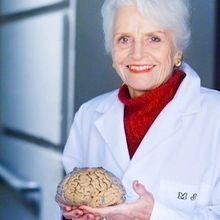neuroplasticity

Be My Vole-entine: How Love and Loss Change the Brain
Paige Nicklas | May 16, 2024 | 4 min read
Neuroscientists studying prairie voles discovered that dopamine in the brain gushes when the animals are with their life partners and that loss of a partner erased this neurochemical signature.

All-nighters Sometimes Combat Depression
Hannah Thomasy, PhD | Jan 5, 2024 | 3 min read
Dopamine pathways play a key role in the surprising effects of sleep deprivation on mood.

Understanding Brain Changes in Response to Extreme Environments
The Scientist | May 17, 2023 | 1 min read
Steven Jillings and Rachael Seidler will discuss the latest advances in understanding neuroplasticity and dysfunctional brain changes in response to spaceflight.

Psychedelics Slip Past Cell Membranes When Treating Depression
Alejandra Manjarrez, PhD | Feb 24, 2023 | 4 min read
The antidepressant properties of hallucinogenic drugs may stem from their ability to bind to intracellular serotonin receptors, a study suggests.

Silent Synapses May Provide Plasticity in Adulthood
Holly Barker, PhD | Dec 13, 2022 | 4 min read
Inactive synapses—found on tiny neuronal projections called filopodia—are abundant in the adult brain, a mouse study suggests.

Ketamine Flips a “Switch” in Mice’s Brain Circuitry: Study
Andy Carstens | Dec 9, 2022 | 6 min read
After injecting moderate doses of the dissociative anesthetic into the animals, previously “awake” brain cells go dark, and those that had been dormant suddenly light up.

How Fear Restructures the Mouse Brain
Natalia Mesa, PhD | Aug 15, 2022 | 4 min read
By combining deep learning and electron microscopy, researchers now have a more detailed understanding of how fear changes the brain.

Neuroscientist Colin Blakemore Dies at 78
Lisa Winter | Jul 6, 2022 | 2 min read
The prolific science communicator specialized in studies of vision and brain plasticity and was the focus of threats from animal rights extremists for several years.

Ursula Bellugi, Leading Sign Language Neuroscientist, Dies at 91
Lisa Winter | May 11, 2022 | 3 min read
Her research showed that communication via sign language is as neurologically complex as spoken language.

Termite Brains Anticipate Future Visual Challenges
Chloe Tenn | Feb 1, 2022 | 2 min read
Dampwood termites with the potential to leave the colony have larger optic lobes before ever being exposed to different visual environments, an example of predictive brain plasticity.

Tinkering with Gut Microbes Boosts Brain Plasticity in Mice
Sophie Fessl, PhD | Jan 13, 2022 | 4 min read
Intestinal bacteria contribute to the effect of stimulating environments on the brain’s ability to adapt, a study concludes.

Exercise-Associated Protein Boosts Brain Function in Mice
Chloe Tenn | Dec 9, 2021 | 5 min read
A study that transfused plasma from active to inactive mice suggests the protein clusterin enhances cognition.

The Neuroscience of Motherhood
The Scientist | Apr 27, 2021 | 1 min read
Robert Froemke and Liisa Galea will discuss the neurological changes that occur during motherhood and their effect on behavior and brain health.

Missing Brain Hemisphere Tied to Fortified Neural Networks
Kerry Grens | Nov 20, 2019 | 2 min read
A small study finds that patients who had half their brains removed to treat epilepsy have stronger neural networks than controls, perhaps explaining how they can retain language and cognition skills.

Infographic: What Makes a Brain Smart?
Shawna Williams | Nov 1, 2018 | 1 min read
Scientists have proposed a variety of features that influence one’s ability to remember things and solve problems.

Pioneering Neuroscientist Dies
Diana Kwon | Jul 31, 2017 | 2 min read
Marian Diamond, a former University of California, Berkeley, professor, discovered the first evidence for neuroplasticity and studied Einstein’s brain.

Contributors
The Scientist | Mar 1, 2017 | 3 min read
Meet some of the people featured in the March 2017 issue of The Scientist.

Added Neurons Are Functionally Integrated into Mouse Brain Circuits
Jenny Rood | Oct 26, 2016 | 3 min read
In vivo imaging reveals how grafted embryonic brain cells grow, connect, and mature into contributing members of damaged visual pathways in adult mice.

Stimulating Novel Neural Circuits in the Mouse Brain
Anna Azvolinsky | Aug 11, 2016 | 3 min read
With light, researchers can coax a group of neurons in the visual cortices of living mice to fire in concert.
